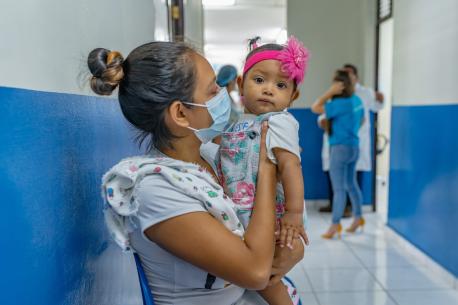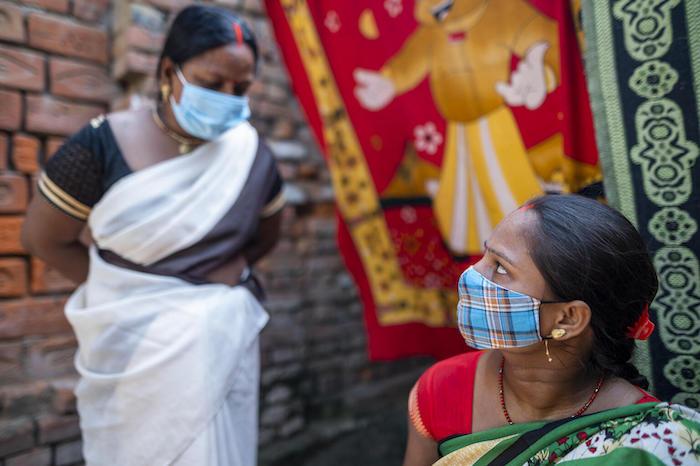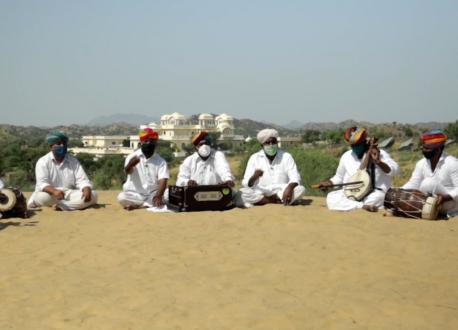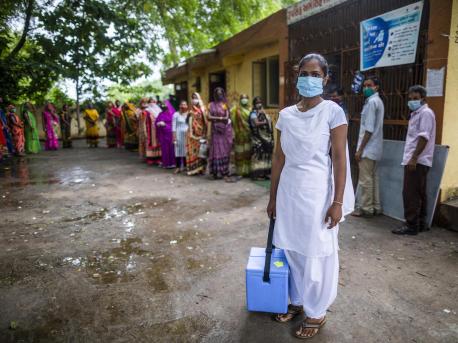
Strengthening Health Systems to Prevent the Next Global Health Crisis
UNICEF and partners reflect on the many lessons from COVID-19 in this Q&A.
UNICEF USA asked three global health experts — Manisha Bhinge, Managing Director of Global Networks and Partnerships for the Rockefeller Foundation’s Pandemic Prevention Institute; Abou Kampo, Director of Health for UNICEF Global Programs; and Lauren Moore, Johnson & Johnson’s Vice President of Global Community Impact — to reflect on the past two years and what needs to happen next to safeguard children, families and communities against future pandemics.
What can be done collectively — or what needs to be done — to end this pandemic and prevent the next one?
ABOU KAMPO (UNICEF): We’ve all just witnessed the cost of a disease outbreak that spun out of control and mutated over the past two years. The cost to the global economy is estimated by the IMF to exceed $12.5 trillion by 2024. We have an opportunity to make sure the COVID legacy is a positive one, where we were able to join together and build on the medical and logistical advances that were achieved during the fight.
We need to focus on a comprehensive and gender-responsive COVID-19 response that addresses both the health and socio-economic impacts of the pandemic with a focus on children, their families and the communities in which they live. The COVID-19 response is important, and UNICEF works every day alongside our ACT-A partners to help governments meet their national targets for tests, vaccines, treatments and PPE, but it should not divert resources, including supply, human resources and finances, from routine health services and other social services, such as education and protection — especially in humanitarian settings.

Bhavna Devi, left, an Accredited Social Health Activist (ASHA), counsels 25-year-old mother Priya Devi on caring for her newborn baby In Varanasi, Uttar Pradesh, India. © UNICEF/UN0564156/Bhardwaj
In addition, increased and comprehensive preparedness is key to adapt to the current public health context and to strengthen the response capacity. Preparedness to infectious disease events should: 1) focus both in preventing and controlling pandemics as well as national and regional level epidemics and outbreaks; 2) be based on country commitments to International Health Regulations (2005); and 3) adopt a whole-of-society approach — one that is not limited to the control of the specific disease causing the epidemic but that also includes a comprehensive strategy for community participation and for mitigating the many ripple effects across societies, communities and families.
UNICEF’s broad expertise and country presence efficiently complements the medical and public health interventions deployed by other partners, in close coordination with the World Health Organization’s mandate. UNICEF’s approach to public health emergencies encompasses both preparedness and response and complements and expands the role of health-only agencies as necessary. UNICEF often plays a lead role in most of the key areas necessary to prevent and control outbreaks.
“When it comes to disease outbreaks and pandemics, the global health architecture is only as strong as its weakest link. We all need to prioritize health system strengthening but we need to work on it together.”
But when it comes to disease outbreaks and pandemics, the global health architecture is only as strong as its weakest link. We all need to prioritize health system strengthening but we need to work on it together. We need a comprehensive approach but also a coordinated one, instead of vertical and narrow funding to specific projects. This is a joint responsibility for donors, national governments, and humanitarian and development organizations.
It’s better when donors provide flexible funding and financing to ensure investments in health care are sustainable and don’t burden countries with debt. When better-resourced countries provide financial, technical and human resources to other countries that are under resourced, everyone benefits.
MANISHA BHINGE (RF): Strengthening systems for routine health services and disease surveillance is a critical first step to a sustainable approach to building a coherent global picture of outbreaks, and then translating that into locally resonant, trusted communications and guidance to influence decisions and action.
Today’s health data ecosystem includes a number of dedicated actors, but also reflects significant gaps and challenges. These include not only fragmented investments but also misaligned incentives, legal restrictions and poor data infrastructure. Moreover, political polarization and the global rise of misinformation have created new challenges for public trust and uptake of information. For certain vulnerable communities, these dynamics build on and exacerbate historical mistrust in public health authorities.
Many of the investments across the backbone efforts have focused on broadening the scope and scale of data inputs and driving novel — but often isolated — analyses. This has left significant gaps and challenges in the ways data is collected and validated within different geographies and populations.
This moment demands innovative thinking and bold action. With the world’s attention on COVID-19, we have a unique window of opportunity to reimagine and redesign the way we collectively develop systems, organize and share data and information and to empower stakeholders to take actions required to protect the world from future public health crises.
What did the pandemic teach us or show us in terms of what works — and what doesn’t work — to ensure equitable access to quality health care and services during a public health emergency?
ABOU KAMPO (UNICEF): COVID-19 showed us that when it comes to global health, we’re all connected. Outbreaks in one part of the world lead to outbreaks in another part of the world. International cooperation to ensure equitable access to health care isn’t just a matter of altruistic solidarity; it is in everyone’s best interests and it’s the scientifically sound thing to do.
The pandemic also showed us how important it is to have a comprehensive response that extends beyond biomedical interventions. There have been huge disruptions in essential health and other social services — including health services not related to COVID — and these disruptions have had a greater negative impact on the well-being of children and women than the COVID-19 disease itself.
There have been huge disruptions in essential health and other social services — including health services not related to COVID — and these disruptions have had a greater negative impact on the well-being of children and women than the COVID-19 disease itself.
In 2020, more than 23 million children around the world missed out on essential vaccines, 17 million of whom received zero vaccinations. These are the ‘zero-dose’ children. As UNICEF works with governments to ‘build back better’ — to help countries shore up their national health systems — we must build resilience while also increasing capacities for delivering primary health care, and continuing to do so in the event of a public health emergency, so that children can get these basic protections; so that immunization coverage is improved, outbreaks are prevented and we are better armed against future crises.
Investment in health and well-being supports social and economic growth and is a prerequisite for sustainable development. Countries with a health expenditure less than $150 per capita will never be able to adequately prepare for or respond to a pandemic. They will not be able to close gaps in immunization or meet targets set by the Sustainable Development Goals.
Investing in health systems is a crucial step, but so is political will. It’s only when public health and primary health care become a priority at national and global levels — as an investment in a country’s people, economy and future — that we can truly expect to see a real improvement in the quality of, and access to, health services.
Why is it so important to invest in frontline health workers as a focus of health system strengthening efforts?
LAUREN MOORE (J&J): Frontline health workers — especially nurses, midwives and community health workers — are often the first and only link between communities and health systems. They are closest to the complex needs of their patients and communities. Health workers are the people at the heart of health systems. And the COVID-19 pandemic has taken a profound toll on them — bringing to light both persistent and new challenges and an urgency to find solutions.
Whether it is providing opportunities for skills training and leadership development, addressing gender inequities and fair compensation, or supporting mental health and well-being, health workers need to be empowered and supported in providing widespread access to quality care. When health workers thrive, health systems are stronger and communities are healthier.
When health workers thrive, health systems are stronger and communities are healthier.
This is why J&J’s Center for Health Worker Innovation is collaborating with partners around the world to address the pre-pandemic projected shortfall of 18 million health workers and to provide resources to help the current health workforce thrive. Through research, training, capacity building, technology and immediate assistance for those taking on COVID-19, we are focused on preparing health workers to deliver the highest quality care — especially where health burdens are greatest.
Our work also includes collaborating with Ministries of Health to formally integrate community health workers into the health system; working to strengthen midwifery education; launching The Resilience Collaborative to advance learning and drive adoption of evidence-based strategies for health worker resilience globally; harnessing digital technologies to help health systems globally do more with the resources they have; and raising health worker voices through storytelling and advocating for nurses during times of crisis.
In addition to our work with non-profit partners, J&J is also investing in transformative ideas and solutions from other channels, including business-led and entrepreneurial innovations with social impact goals. It’s critical that we find ways to support social entrepreneurs who are working to fill gaps in their country’s health system and improve access to quality care in underserved communities.
Why is it important to take a data-driven approach to pandemic response and health system strengthening?
MANISHA BHINGE (RF): Pandemic impacts — both direct and indirect — highlighted the need to not only identify outbreaks early and mount a targeted response, but to also ensure the resilience of routine health service provision. The role of timely data and evidence from health facilities and communities, combined with other critical data sources, is foundational to decision-making around such efforts.
But there are some long-standing challenges with our data backbone to prevent, detect, characterize and rapidly respond to emerging disease threats that need to be addressed. We see a plethora of efforts to track specific disease areas, but there is no overarching global architecture to align data and information from multiple sources with the needs of public and private decision makers. The current tools used for global disease forecasting do not fully benefit from cross-sector collaboration or from the application of artificial intelligence and innovative analytical tools that can create more nuanced insights.
The current tools used for global disease forecasting do not fully benefit from cross-sector collaboration or from the application of artificial intelligence and innovative analytical tools that can create more nuanced insights.
Similarly, observations from vigilant frontline health workers — who played a vital role in sounding the alarm on outbreaks like SARS, Ebola and COVID-19 — are not systematically harvested through smartphones or other participatory surveillance systems.
As a result of these gaps, decision makers — from local governments to businesses to community leaders — lack timely information to understand pandemic threats, make quick decisions and focus limited resources on where they are needed most. This is further complicated by two other factors: lack of trust in information and ineffective communication of available data.
As we enter the third year of this pandemic, we have plenty of evidence supporting the role of digital technology and data science in enabling not only the recovery efforts but also supporting the continuity of essential health services during lockdowns.
For instance: early in the pandemic, the enforcement of a national lockdown resulted in a major exodus of migrant labor for major cities in India. Through the Rockefeller Foundation’s partnership with UNICEF in the country — where we focused on leveraging data science to strengthen community health services — we were able to rapidly deploy digital technologies to enable tracking and community surveillance of more than 2 million migrants. This is a clear example of a data-driven approach to strengthening the resilience of frontline health systems for timely and targeted response at a time of significant disruption to reduce the vulnerability of this population and to help control the spread of COVID.
More about these partners
J&J: Since January 2020, the Johnson & Johnson Family of Companies and the Johnson & Johnson Foundation have made $500 million in new commitments to quality, accessible, culturally competent care — guided by the perspectives and lived experiences of those on the front lines of care: nurses, midwives, community health workers; entrepreneurs and communities developing models of culturally competent care; and partners and colleagues. In addition to its work with non-profit partners, J&J is investing in transformative ideas and solutions from other channels, including business-led and entrepreneurial innovations with social impact goals. This includes Our Race to Health Equity, a $100-million, five-year commitment in the U.S. to eliminate racism as a public health threat by leveraging J&J’s unique role within global health systems to improve diversity in clinical trials, support culturally competent care models and build a generation of more representative doctors and nurses. Johnson & Johnson Impact Ventures finds and supports social entrepreneurs and provides funding through the Johnson & Johnson Foundation to build up mission-driven companies that are extending access to quality care.
Rockefeller Foundation: Building on its work in harnessing digital technology and data science for health, the Rockefeller Foundation launched the Pandemic Prevention Institute (PPI) in 2021 to facilitate partnerships between public and private sectors to create and integrate diverse and disparate data sets from a range of global collaborations and sources. PPI will work with a global network of partners to align data sets and develop analytical tools that communities can use to enable decisions to contain outbreaks and prevent pandemics. Rockefeller and UNICEF have partnered together to support countries to leverage data and analytic tools to accelerate progress towards improved health outcomes by overcoming health system bottlenecks at the community level.
UNICEF: UNICEF has been responding to the impacts of the pandemic since its earliest days — from providing critical PPE and medical supplies, to ensuring children can still access essential health care, routine vaccinations, education and other essential services. Around the world, UNICEF teams continue to work tirelessly to help more than 130 countries tackle COVID-19 and its wider impacts on children and their families. UNICEF’s work focuses on increasing resilience across communities and systems and building capacities to respond to public health emergencies using local knowledge to inform practice, advocacy and policy at all levels. This bottom-up approach is at the core of UNICEF’s health system strengthening work. UNICEF looks to leverage existing strengths while working with partners to meet the needs of children everywhere.
TOP PHOTO: In San Julián, Sonsonate, El Salvador, a mother brings her baby to the pediatrician for a routine checkup arranged through Care for Child Development (CCD), a program implemented by UNICEF in Latin America and the Caribbean. © UNICEF/UN0499578/Segovia Prado

